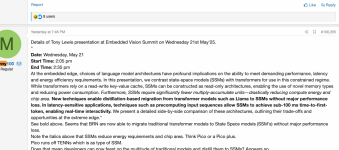Kingkong2015
Regular
wrong.Source: Grok
LLaMA-1B (a hypothetical 1 billion parameter model from the LLaMA family, as Meta AI's LLaMA models typically come in larger sizes like 7B, 13B, etc.) or a similarly sized model could potentially be run on BrainChip's Akida Pico, but it would require significant optimizations to fit within the chip's ultra-low-power and resource-constrained architecture. Here's a detailed breakdown:
### Feasibility of Running LLaMA-1B on Akida Pico
1. **Akida Pico's Constraints**:
- **Power and Memory**: The Akida Pico is designed for ultra-low power consumption (<1 milliwatt) and has limited on-chip SRAM for model weights and processing. It’s optimized for event-based, neuromorphic computing (spiking neural networks, SNNs) rather than traditional dense matrix operations used in transformer-based LLMs like LLaMA.
- **Compute**: The chip excels at lightweight tasks (e.g., voice wake detection, keyword spotting) and is not designed for the heavy floating-point computations required by large transformer models without optimization.
2. **LLaMA-1B Requirements**:
- **Model Size**: A 1B parameter model, assuming 16-bit (FP16) precision, requires approximately 2GB of memory for weights alone (1 parameter = 2 bytes in FP16). With 8-bit (INT8) quantization, this could be reduced to ~1GB, and 4-bit quantization could further shrink it to ~500MB. Additional memory is needed for activations, context, and intermediate computations, potentially pushing total memory needs to 1.5–3GB even with optimizations.
- **Inference Compute**: Inference for a 1B parameter transformer model involves billions of multiply-accumulate operations per token, which is computationally intensive for a low-power chip like the Akida Pico. Techniques like pruning or sparse activations could help, but the chip’s event-based architecture requires the model to be adapted to SNNs or similar formats.
- **Latency**: On resource-constrained edge devices, inference for a 1B model could take seconds per token without hardware acceleration tailored for transformers, making real-time applications challenging.
3. **Optimizations Required**:
To run a LLaMA-1B or similar 1B parameter model on the Akida Pico, the following optimizations would be critical:
- **Quantization**: Reducing precision to 8-bit or 4-bit (e.g., using techniques like post-training quantization or quantization-aware training) to shrink memory footprint and computational load. This is feasible, as models like LLaMA can maintain reasonable performance with low-bit quantization.
- **Model Pruning**: Removing redundant weights or layers to reduce the model size and computation, though this may degrade performance for general tasks.
- **Distillation**: Training a smaller, more efficient model to mimic LLaMA-1B’s behavior, potentially reducing the parameter count further (e.g., to 500M parameters) while retaining key capabilities.
- **SNN Conversion**: Converting the transformer model to a spiking neural network compatible with the Akida Pico’s neuromorphic architecture. BrainChip’s MetaTF framework supports converting traditional neural networks (e.g., CNNs) to SNNs, but adapting a transformer-based LLM like LLaMA would require significant research and engineering.
- **Task-Specific Fine-Tuning**: Limiting the model to a specific domain (e.g., voice commands, appliance control) to reduce complexity and memory needs. For example, fine-tuning LLaMA-1B on a dataset of appliance manuals could make it more suitable for the Akida Pico’s use case.
4. **Software Support**:
- BrainChip’s MetaTF framework allows developers to optimize and deploy models using standard AI workflows (TensorFlow, PyTorch). It can map neural networks to the Akida Pico’s event-based architecture, but transformer models like LLaMA require additional preprocessing to align with SNNs.
- The framework’s ability to handle on-chip learning could enable incremental fine-tuning on the device, reducing reliance on large pre-trained weights.
5. **Challenges**:
- **Memory Bottleneck**: Even with 4-bit quantization (~500MB for weights), the Akida Pico’s SRAM is likely far smaller than needed for a 1B parameter model. Off-chip memory access (e.g., via external flash) could help but would increase power consumption and latency, countering the chip’s low-power design.
- **Compute Mismatch**: Transformers rely on dense matrix operations, while the Akida Pico is optimized for sparse, event-driven computations. Converting LLaMA-1B to an SNN-compatible format without significant performance loss is a non-trivial research challenge.
- **Latency for Real-Time Use**: Even with optimizations, generating text with a 1B model on the Akida Pico could be slow (e.g., seconds per token), limiting its use for interactive applications like chatbots unless heavily tailored.
6. **Comparison to Smaller Models**:
- Smaller models, like Pythia-70M or DistilBERT (~100M parameters), are far more feasible for the Akida Pico. These require ~200MB (FP16) or ~50–100MB (4-bit) for weights, fitting more comfortably within the chip’s constraints. BrainChip has demonstrated running small, use-case-specific LLMs (e.g., for smart appliances), suggesting that a 1B model is at the upper limit of feasibility.
- A distilled version of LLaMA-1B (e.g., reduced to 500M parameters) would be more practical and align better with the chip’s capabilities.
### Practical Scenarios
- **Feasible Use Case**: A heavily quantized, fine-tuned, and SNN-converted LLaMA-1B model could run on the Akida Pico for a specific task, such as processing voice commands or answering queries about a device’s user manual. For example, a smart speaker could use the model to respond to simple queries locally, consuming minimal power.
- **Example Workflow**:
1. Start with LLaMA-1B or a similar 1B parameter model.
2. Apply 4-bit quantization and pruning to reduce the model size to ~500MB.
3. Fine-tune on a narrow dataset (e.g., appliance manuals).
4. Use MetaTF to convert the model to an SNN compatible with the Akida Pico.
5. Deploy for inference on the chip, leveraging on-chip learning for minor updates.
### Conclusion
Running a LLaMA-1B or similar 1 billion parameter model on BrainChip’s Akida Pico is theoretically possible but pushes the chip’s limits. It would require aggressive optimizations like 4-bit quantization, pruning, distillation, and conversion to a spiking neural network, along with task-specific fine-tuning to reduce memory and compute demands. Even then, inference may be slow, and the model’s general-purpose capabilities would likely be constrained to niche applications (e.g., voice assistants, appliance control). Smaller models (e.g., 70M–500M parameters) are far more practical for the Akida Pico’s ultra-low-power, neuromorphic design.
Source: Grok
transformer model -> state space model -> akida.

